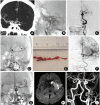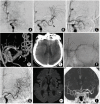Causes and Solutions of Endovascular Treatment Failure
- PMID: 28592777
- PMCID: PMC5466284
- DOI: 10.5853/jos.2017.00283
Causes and Solutions of Endovascular Treatment Failure
Abstract
In a meta-analysis of individual patient data from 5 randomized controlled trials, endovascular treatment (EVT) mainly using a stent retriever achieved successful recanalization in 71.1% of patients suffering from acute stroke due to anterior circulation large artery occlusion (LAO). However, EVT still failed in 28.9% of LAO cases in those 5 successful trials. Stent retriever failure may occur due to anatomical challenges (e.g., a tortuous arterial tree from the aortic arch to a target occlusion site), a large quantity of clots, tandem occlusion, clot characteristics (fresh versus organized clots), different pathomechanisms (embolic versus non-embolic occlusion), etc. Given that recanalization success is the most important factor in the neurological outcome of acute stroke patients, it is important to seek solutions for such difficult cases. In this review, the basic technique of EVT is briefly summarized and then various difficult cases with diverse conditions are discussed along with suggested solutions.
Keywords: Acute stroke; Endovascular thrombectomy; Stent retriever.
Conflict of interest statement
The author has no conflicts of interest.
Figures










References
-
- Berkhemer OA, Fransen PS, Beumer D, van den Berg LA, Lingsma HF, Yoo AJ, et al. A randomized trial of intraarterial treatment for acute ischemic stroke. N Engl J Med. 2015;372:11–20. - PubMed
-
- Campbell BCV, Mitchell PJ, Kleinig TJ, Dewey HM, Churilov L, Yassi N, et al. Endovascular therapy for ischemic stroke with perfusion-imaging selection. N Engl J Med. 2015;372:1009–1018. - PubMed
-
- Goyal M, Demchuk AM, Menon BK, Eesa M, Rempel JL, Thornton J, et al. Randomized assessment of rapid endovascular treatment of ischemic stroke. N Engl J Med. 2015;372:1019–1030. - PubMed
-
- Jovin TG, Chamorro A, Cobo E, de Miguel MA, Molina CA, Rovira A, et al. Thrombectomy within 8 hours after symptom onset in ischemic stroke. N Engl J Med. 2015;372:2296–2306. - PubMed
-
- Saver JL, Goyal M, Bonafe A, Diener HC, Levy EI, Pereira VM, et al. Stent-retriever therombectomy after intravenous t-PA vs. t-PA alone in stroke. N Engl J Med. 2015;372:2285–2295. - PubMed
Publication types
LinkOut - more resources
Full Text Sources
Other Literature Sources

